
KAPELL: AUSTRALIAN TOUR JULY 18 – OCTOBER 22, 1953 – 37 CONCERTS – II/III
William KAPELL: II Concerts n° 15-20 (AUGUST 29 – SEPTEMBER 12)
SYDNEY, NEWCASTLE, MAITLAND
TRIBUTE TO WILLIAM KAPELL: 70 years ago, William Kapell made his second Tour in Australia. The 37 concerts are listed for the first time. Here are the programs and reviews of concerts n°15 to 20.
On August 27, the Executive Committee of the Sydney SO arranged a reception at the Royal Empire Society for visiting pianist William Kapell. On the picture below, he is talking with Mrs. A.H. Chartres, Secretary of the Committee.

But, on August 29, the day of Kapell’s first concert in Sydney, he was ‘greeted’ by an article entitled ‘No Fancy Dress Mozart, Please’, published in ‘The Sydney Morning Herald’ under the name of Lindsey Browne, and aiming mainly at telling Kapell how he should play Mozart. Another negative article came out the next day. Kapell’s interview for the ‘Sunday Herald’ was published on August 30 under the title ‘The Deceptive Manner of William Kapell ’.
15- August 29 SYDNEY TOWN HALL SYDNEY SO dir: Eugene GOOSSENS (1893 – 1962)
RACHMANINOV Concerto n°3 – MOZART Concerto n°17 K.453

Announcement of the concert / Broadcast of the 1st part of the concert
The Sydney Morning Herald (August 31):’The American pianist, William Kapell, was pleasant and interesting company during the two concertos which he played at the Town Hall on Saturday with lhe Sydney Symphony Orchestra under Eugene Goossens. If it was not an occasion for highly memorable experiences, there was yet bountiful evidence of efficient and thoughtful craftsmanship in Mr. Kapell’s well reasoned approach to the concertos by Rachmaninoff (No. 3) and Mozart (No. 17 K453), and both were cordially applauded. The Mozart was the finer achievement. In the florid and rhetorical Rachmaninoff work, Mr. Kapell offered an interesting new point of view, without making a wholly convincing case for it. He seemed determined from the start to have no truck with the full-blown romance that the Olympians find in this airless, oppressive work. There was to be no « ham. » Right from the opening melody, which he played with coaxing modesty, to be overheard rather than heard, he chose the way of restraint and balance and that, of course, was not always to the advantage of a composer whose habit is to lay the colours on thick. In the gentlest lyrical episodes, Mr. Kapell had a poet’s way of bringing an exquisite quietude to the music; elsewhere, often, his Rachmaninoff was unduly lean and athletic. It was a musicianly idea to reserve the big display of thunder and explosions until the final movement, but even here, in the stockpiling of great sonorities, and the cascading filigree, Mr.Kapell gave an impression of vitality and efficiency, rather than of brilliant romantic colour. The Mozart performance was fluent, limpid and full of character, with barely a trace of the neuter metronomics that kill Mozart lt was not perhaps Mozart played to transport every audience to realms of light, but the quality of both the humour and the tragedy was unmistakable. The pianist’s absorption in the feeling of the slow movement, with strings expressing themselves in sudden dark downstrokes of pain, and his wit in the ingenious dialogues between piano and orchestra in the finale produced some admirable music’. Lindsey Browne
The Sun (August 31): ‘After an absence of eight years, American pianist William Kapeli greeted a large audience at a Town Hall concert on Saturday night with some uncommonly attractive playing in each of two concertos—one of them as common by nature as the other is attractive. The concertos were Rachmaninoff’s. the third in D minor, and Mozart’s, in G major K.453. Both were received with equal warmth by a large audience. Whether this was due to an increasing sophistication in musical taste in Sydney or the fact that Kapell played them might provide fruitful argument for idealists on the one hand and cynics on the other. At all accounts, it was a rare delight to hear a Mozart concerto played with the aristocratic polish and well-bred charm which Kapell brought to the music. He was not helped, in bringing the solo part to a fine edge, by some plebeian playing on the part of the orchestra, which was, in any case, too large…. The sharpness of definition and rhythmic vitality of the Mozart were equally obvious qualities in the performance of the Rachmaninoff, which was played first. But where calculation and a cool head are a necessary part of Mozart, they are anathema to Rachmaninoff. Kapell seemed unable to accept the need for fulsome flourish and extravagant lyricism, which the music demands above all else. John Moses
15bis- August 30 Sunday Night Celebrity (ABC Sydney)
Scarlatti Sonata – Copland Sonata
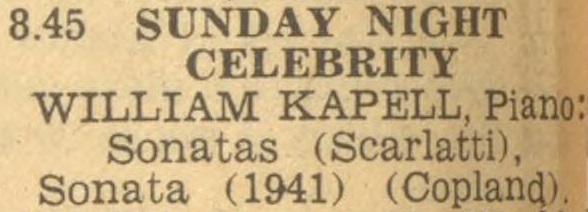
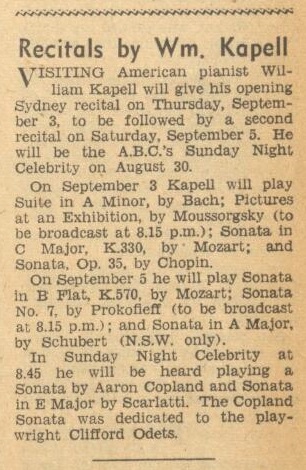
16- September 03 SYDNEY TOWN HALL Program n°1
BACH Suite BWV818 – MOUSSORGSKY Pictures at an Exhibition – MOZART Sonata K.330 – CHOPIN Sonata n°2 Op.35

Announcement of the concert / Broadcast of the 1st part of the concert
The Sydney Morning Herald (September 4): ‘Sentimental humbug was rigorously shut out from the keen, crisp performances given at the Town Hall last night by the American pianist, William Kapell, and a good deal of reputable sentiment and warm colour was shut out with it. His programme offered a double contrast between classics and romantics… Not often did Mr. Kapell let it be supposed that any of this music was more than shallowly exciting. It came from him, rather, as a somewhat cool, intellectual game, a disciplined exercise in the physics of tone. It was methodical. It was businesslike. Perhaps this extreme detachment of style is Mr Kapell’s reaction to too many earlier charges of « immaturity » – if so, it is a reaction that may prove fruitful in time. At all events, his vigilant efficiency as a technician was never in doubt last night, and there was vitality and interest in nearly all that his hands and mind « machined. » The Bach, a dry work, was played with dry composure until the final gigue, and that was assailed with unclassic harshness of weight and energy. The Mozart was elegant, decorative, impatient in the andante, generally impersonal and unsmiling. The Chopin, noisy early, became radiant for the funeral march, despite under-emphasis of the bass’s tread and dolor, and found uncommonly fateful beauty in the shuddering winds of the finale. Moussorgsky’s « Pictures, as usual, were a popular success, incisively witty in many places. The minstrel’s song might have been sweeter, Mr Schmuyle might have been more of a whimperer, Mr Goldenberg might have been fatter, the peasant’s weary oxen might have drudged along instead of boasting of their strength – but lighter interludes about the unhatched chickens and the Tuileries nursemaids were quite charming. Lindsey Browne
Daily Telegraph (September 4): ‘Think of the few great pianists you have heard and put the name of William Kapell beside them — for that is where it belongs. At the Town Hall last night, Kapell gave superb performances in the first of three recitals he is to give in this city. Glowing adjectives are inadequate to describe the beauty of his tone, the colossal magnitude of its size, his control of nuance, the delicacy of phrasing, the thought and sensitivity that colored everything he played. He gave to the music a most rare intensity, an emotional weight that gripped his audience and held them. And this in a programme chosen, surely, for the connoisseur. For a Bach Suite framed Moussorgsky’s « Pictures at An Exhibition » and Mozart’s C major sonata preceded the B flat minor Sonata of Chopin in the second half. Kapell’s interpretation of the Moussorgsky Pictures was something quite extraordinary in its startling vividness, its breathtaking power. And this was true also of the Chopin Sonata, where tenderness was always allied to strength and there was nothing to cloy the palate. It was Chopin on a truly hig scale a Chopin of noble power and proportions’. Eunice Gardiner
17- September 05 SYDNEY TOWN HALL Program n°2
MOZART Sonata K.570 – PROKOFIEV Sonata N°7 OP.83 – SCHUBERT Sonata A Major D.959

Announcement of the concert / Broadcast of the 1st part of the concert
The Mozart and Prokofiev sonatas have already been broadcast on July 25. So, ABC missed the opportunity of broadcasting nationwide the Schubert Sonata, new to Kapell’s repertoire.
The Sydney Morning Herald (September 7): ‘Pianist William Kapell had two outstanding successes at his Town Hall recital on Saturday night. One of them was perhaps inevitable, the other more unexpected. One of the works was Prokofiev’s Seventh Sonata, which is perfectly suited to Kapell’s muscular and forthright virtuosity, the other was Schubert’s great A Major Sonata, which one would have thought less suited to the rather hard-edged, black-and white style he revealed at his first recital. The quick movements of the Prokofiev made an exciting essay in pounding rhetoric, machine-like articulation, precipitous contrast, and driving impetus. It was grand fun, but it still could not prove that this later Prokofiev work is a great, rather than entertaining, piece of music. The slow movement, with its parody of a sentimental ballad tune, is hardly even entertaining. Kapell commanded attention throughout the 35-minute Schubert sonata with the breadth of his design and the surprising warmth of his sympathy. The work, with its wide range of emotional territory and the length of its periods, is not an easy one to keep under control. Once or twice a melody was brought rather too severely into relief where it should have been gently embraced by its accompaniment. But in general it was an engrossing performance of a too-little-known work. The recital opened with a Sonata in B Flat by Mozart, the slighter of the two familiar sonatas in that key. It was done with graceful, rather cool, efficiency, relieved by a deft touch of humour in the last movement. M.L.
Daily Telegraph (September 6): ‘American pianist William Kapell showed fine quality in his three-sonata recital at the Town Hall last night. The sonatas were very mature examples of each composer – Mozart B flat K.570, Prokofieff No. 7 and Schubert A major, one of three published as Schubert’s very last compositions. Kapell’s treatment of them was also very mature. He puts immense thought behind his music, plans it carefully and goes about it deliberately. Perhaps that is why Kapell presented the long-winded Schubert Sonata as purposeful music in which he had found poetic enjoyment. His Mozart was impeccable without being fussy – the last two movements at least – and had a perky vitality. But if anything had vitality, it was his powerful impression of the Prokofieff sonata. Kapell has come back to us as a pianist of some stature’. T.F.M.
18- September 08 NEWCASTLE CENTURY THEATRE BROADMEADOW
MOZART Sonate K331 – CHOPIN Sonate n°2 OP.35 – DEBUSSY Suite Bergamasque –SCHUBERT Impromptus Op.142 D.935 n° 1,2 – LISZT Hungarian Rhapsody n°11
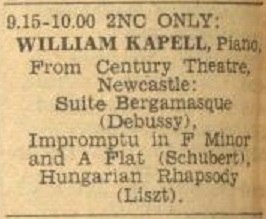
Broadcast of the 2nd part of the concert
19- September 09 MAITLAND TOWN HALL
MENDELSSOHN 4 Songs Without Words – CHOPIN Barcarolle – Nocturne Op.55 – Scherzo n°1 Op.20 Waltz in E Flat
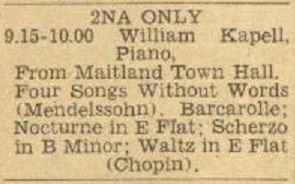
Broadcast of the 2nd part of the concert
19bis-Thursday September 10 « ANYTHING BUT JAZZ » presented by WILLIAM KAPELL
SYDNEY THE THEATRETTE BROADCAST HOUSE (ABC YOUTH CONCERT COMMITTEE)
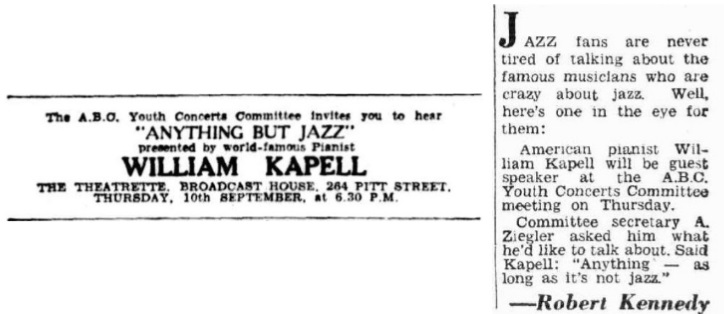
20- September 12 SYDNEY TOWN HALL Program n°3
SCARLATTI 4 Sonatas – COPLAND Sonata – DEBUSSY Suite Bergamasque – CHOPIN Barcarolle Op.60 -Nocturne Op.55 N°2 – Scherzo n°1 Op.20

Announcement of the concert / Broadcast of the 1st part of the concert
After having been told by the ABC presentation officer to do so, Kapell performed the US National Anthem before the ‘God save the Queen’, which led to a minor scandal, but the misundersanding was soon explained by ABC.
The Sydney Morning Herald (September 14): ‘The American pianist, William Kapell, gave a stylish performance of Debussy’s Suite Bergamasque at the Town Hall on Saturday, and he made out for Copland’s 1941 sonata just about as good a case as could ever be made for this dry, austere work. Mr. Kapell’s aggressive approach to four Scarlatti sonatas early, with tone as hard as New York asphalt and moods twitching like Times Square neon, must have left his audience quite unprepared for the antic elegance, the exquisite transparencies of texture, and the subtle tasting of vintage sensations in his Debussy playing….Mr. Kapell played Copland’s sonata incisively, with the air of stubborn defiance that suits its percussive chords, and he was careful not to let the work go soft during the bell ringer’s harmonies of the first movement. In a work that could easily seem scrappy and improvisatory, the pianist did well to find and preserve a firmly unified design’. Lindsey Browne
The Sun (Sept 13): ‘Kapell played an austere sonata of marked originality by Aaron Copland, and four tiny sonatas by Scarlatti, where the dryness of harpsichord tone was disturbingly absent’… In the second half, there was none of the emotional reticence that has been a feature of some of his recent playing in Sydney. Instead, there was warmth without gush and elegance without prettification. The last two items in Debussy’s Suite Bergamasque were enchanting studies in delicately weighed dynamics and cool phrasing. In the final Chopin group, Kapell showed himself to be a very fine pianist indeed. A masterly performance of the Barcarolle was followed by a movingly romantic Nocture in E Flat, Op.55. He finished his concert with an electrifying account of the B Minor Scherzo’. JBR
Of course, Browne’s remark about the Scarlatti Sonatas hurt Kapell. But, even before, tired and rather depressed, he thought of cancelling the remaining concerts, but he couldn’t in view of the considerable amount of money he would have had to refund, which means he had no choice but to give the 17 remaining concerts.




3 réponses sur « KAPELL: AUSTRALIAN TOUR JULY 18 – OCTOBER 22, 1953 – 37 CONCERTS – II/III »
Aaaaaah, it continues… 🙂 « Hollywood’s conception of a trouble-shooting private eye » 😀 … interesting, he did not like Bartok and did talk negative on him. « But I don’t get anything from Bartok… » Was he too young to get something from Bartok?
In another interview (New Orleans Dec 1952), he said: ‘The danger today is one of musical conformism… There is splendid piano music by Hindemith, Copland, Sessions and Bartok, but no one wants to listen to it. This provides a deterrent to the contemporary composer, of course, since he wants his music heard.’
It is a lot more rewarding to hear him play than to read what he said on the spur of the moment, which was sometimes provocative! The problem also is that some Sydney music critics were fully against him and did not hesitate to write things that were close to being insulting.
An interesting point in the interview. Kapell said: ‘They chopped a minute off the end of a broadcast of a recital in Melbourne to make way for a sports announcement or something. But I believe there was a row about that’.
This might be the explanation why the end of the ‘Pictures at an Exhibition’ was missing from the recording. In the published CD, it is patched from the Frick Collection Recital.